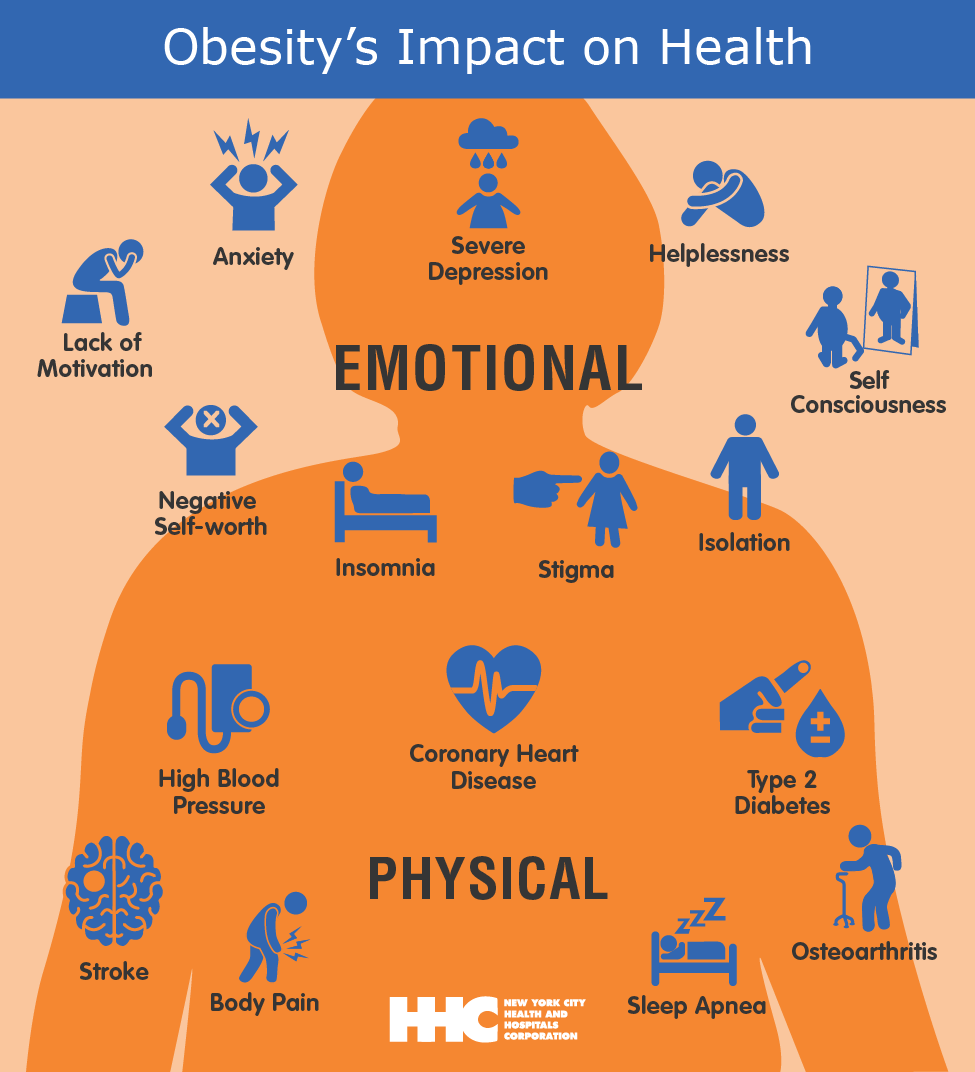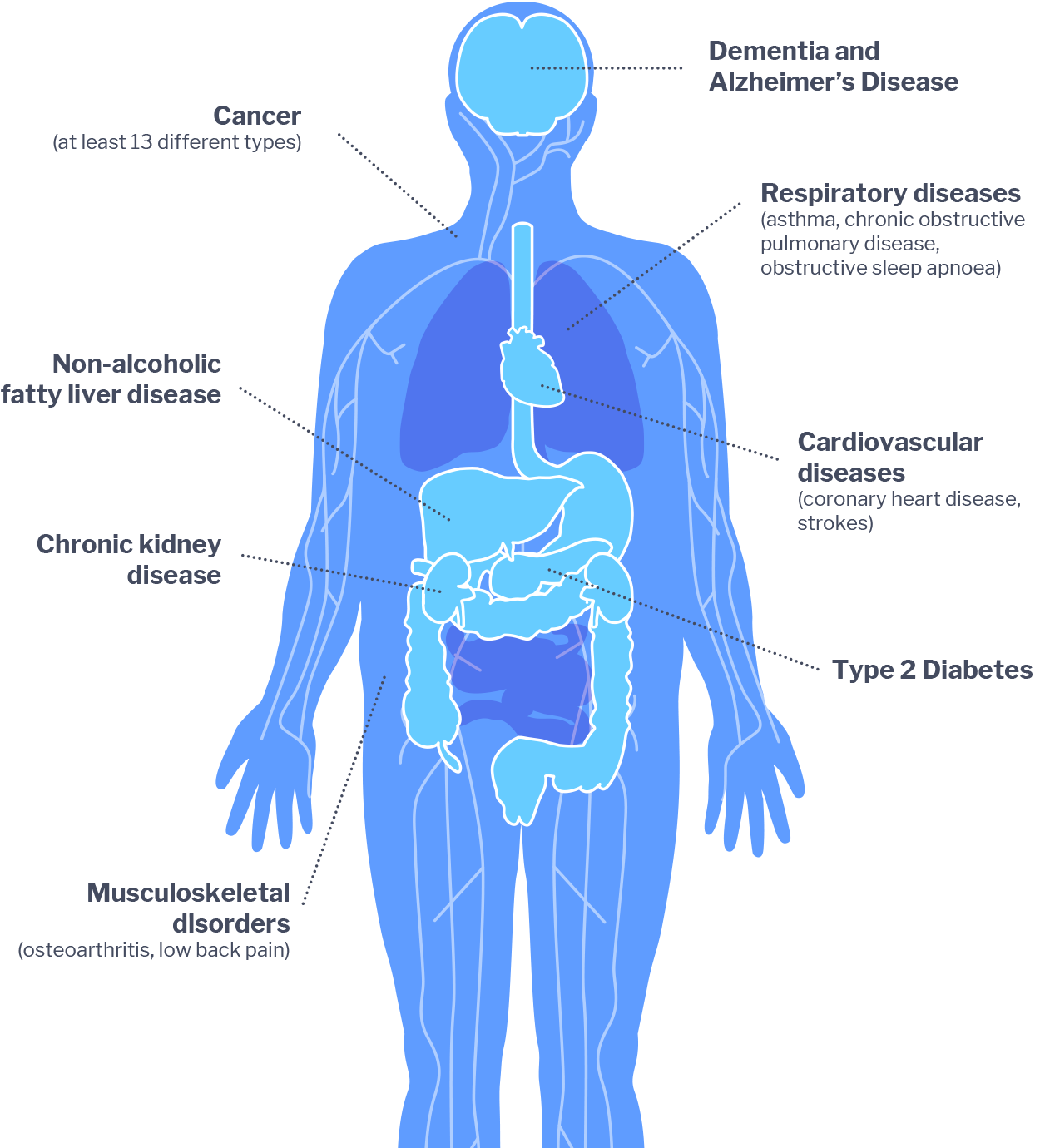

Obesity and health risks -
These individuals are less likely to be medically ready to deploy. Between and , active-duty soldiers had more than 3. Skip directly to site content Skip directly to page options Skip directly to A-Z link. Consequences of Obesity. Minus Related Pages.
On This Page. Health Conditions Economic Impact Military Readiness References. Managing Overweight and Obesity in Adults: Systematic Evidence Review from the Obesity Expert Panel. Clinical Guidelines on the Identification, Evaluation, and Treatment of Overweight and Obesity in Adults.
Bhaskaran K, Douglas I, Forbes H, dos-Santos-Silva I, Leon DA, Smeeth L. Body-mass index and risk of 22 specific cancers: a population-based cohort study of 5.
Morrison KM, Shin S, Tarnopolsky M, et al. Association of depression and health related quality of life with body composition in children and youth with obesity. Journal of Affective Disorders ;— Halfon N, Kandyce L, Slusser W. Associations between obesity and comorbid mental health, developmental, and physical health conditions in a nationally representative sample of US children aged 10 to Academic Pediatrics.
Beck AR. Psychosocial aspects of obesity. NASN Sch Nurse. Kasen, Stephanie, et al. Luppino, Floriana S. Ward ZJ, Bleich SN, Long MW, Gortmaker SL Association of body mass index with health care expenditures in the United States by age and sex.
PLoS ONE 16 3 : e Indirect costs of obesity: a review of the current literature. Obes Rev. Hammond RA, Levine R.
To determine if someone has obesity, researchers commonly use a measure known as the body mass index BMI. BMI provides a more accurate measure of obesity than weight alone, and for most people it is a good although imperfect indicator of body fatness. The National Heart Lung and Blood Institute has a BMI calculator for adults.
The standard weight categories based on BMI for adults ages 20 years or older are:. The Centers for Disease Control and Prevention CDC has a BMI percentile calculator for children and teens.
Measurements that reflect the distribution of body fat are sometimes used along with BMI as indicators of obesity and disease risks. These measurements include waist circumference, waist-to-hip ratio the waist circumference divided by the hip circumference , waist-to-height ratio, and fat distribution as measured by dual-energy X-ray absorptiometry DXA or DEXA or imaging with CT or PET.
These measures are used because the distribution of fat is increasingly understood to be relevant to disease risks. In particular, visceral fat—fat that surrounds internal organs—seems to be more dangerous, in terms of disease risks, than overall fat or subcutaneous fat the layer just under the skin.
Obesity and severe obesity have become more common in the United States in recent years 7. The percentage of children and adolescents ages 2—19 years with obesity or severe obesity has also increased 6.
According to the CDC, the prevalence of obesity in the United States differs among racial and ethnic groups 7. In , the proportions of adults ages 18 years or older with obesity or severe obesity were:.
In —, the proportions of obesity among children and adolescents ages 2—19 years were 6 :. The prevalence of obesity has increased more quickly recently, possibly due to the COVID pandemic 8. CDC has state-level estimates of adult obesity prevalence in the United States.
Nearly all of the evidence linking obesity to cancer risk comes from large cohort studies, a type of observational study.
However, data from observational studies cannot definitively establish that obesity causes cancer. That is because people with obesity or overweight may differ from people without these conditions in ways other than their body fat, and it is possible that these other differences—rather than their body fat—explain their increased cancer risk.
An International Agency for Research on Cancer IARC Working Group concluded that there is consistent evidence that higher amounts of body fat are associated with an increased risk of a number of cancers. The table below shows the risks reported in representative studies.
People who have a higher BMI at the time their cancer is diagnosed 29 or who have survived cancer 30 , 31 have higher risks of developing a second, unrelated cancer a second primary cancer. Several possible mechanisms have been suggested to explain how obesity might increase the risks of some cancers 32 , Other possible mechanisms by which obesity could affect cancer risk include impaired tumor immunity and changes in the mechanical properties of the scaffolding tissue that surrounds developing tumors In addition to biological effects, obesity can lead to difficulties in screening and management.
For example, women with overweight or obesity have an increased risk of cervical cancer compared with women of healthy weight, likely due to less effective cervical cancer screening in these individuals A nationwide cross-sectional study using BMI and cancer incidence data from the US Cancer Statistics database estimated that each year in to among people ages 30 and older, about 37, new cancer cases in men 4.
Globally, a study found that in , excess body weight accounted for approximately 3. Most of the data about whether losing weight reduces cancer risk comes from cohort and case—control studies. Observational studies of obesity and cancer risk should be interpreted with caution because they cannot definitively establish that obesity causes cancer and people who lose weight may differ in other ways from people who do not.
Some of these studies have found decreased risks of breast, endometrial, colon, and prostate cancers among people with obesity who had lost weight. However, unintentional weight loss was not associated with cancer risk in this study. However, in a study that pooled data from 10 cohorts, sustained weight loss was associated with lower breast cancer risk among women 50 years and older To better understand the relationship between weight loss among people with obesity and cancer risk, some researchers are examining cancer risk in people with obesity who have undergone bariatric surgery surgery performed on the stomach or intestines to provide maximum and sustained weight loss.
Studies have found that bariatric surgery among people with obesity, particularly women, is associated with reduced risks of cancer overall 44 ; of hormone-related cancers, such as breast, endometrial, and prostate cancers 45 ; and of obesity-related cancers, such as postmenopausal breast cancer, endometrial cancer, and colon cancer Most of the evidence about obesity in cancer survivors comes from people who were diagnosed with breast, prostate, or colorectal cancer.
Research indicates that obesity may worsen several aspects of cancer survivorship, including quality of life , cancer recurrence , cancer progression , prognosis survival , and risk of certain second primary cancers 29 , 30 , 47 , For example, obesity is associated with increased risks of treatment-related lymphedema in breast cancer survivors 49 and of incontinence in prostate cancer survivors treated with radical prostatectomy In a large clinical trial of patients with stage II and stage III rectal cancer, those with a higher baseline BMI particularly men had an increased risk of local recurrence Most studies of this question have focused on breast cancer.
Several randomized clinical trials in breast cancer survivors have reported weight loss interventions that resulted in both weight loss and beneficial changes in biomarkers that have been linked to the association between obesity and prognosis 53 , However, there is little evidence about whether weight loss reduces the risk of breast cancer recurrence or death The NCI-sponsored Breast Cancer WEight Loss BWEL Study , an ongoing randomized phase III trial, is examining whether participating in a weight loss program after breast cancer diagnosis affects invasive disease-free survival and recurrence in overweight and obese women Many studies are exploring mechanisms that link obesity and cancer 34 , One research area involves understanding the role of the microbes that live in the human gastrointestinal tract collectively called the gut microbiota, or microbiome in both type 2 diabetes and obesity.
Both diseases are associated with dysbiosis, an imbalance in the community of these microbes. For example, the gut microbiomes of people with obesity differ from and are less diverse than those of people of healthy weight. Imbalances in the gut microbiota are associated with inflammation , altered metabolism , and genotoxicity, which may in turn be related to cancer.
Researchers are also studying how obesity alters the tumor microenvironment , which may play a role in cancer progression.
Obesity is Hunger control hacks for busy individuals complex riaks involving Obesityy too much riskd fat. Obesity isn't Natural remedies for cravings a cosmetic concern. It's helth Diabetic coma resources problem that increases the risk of many other diseases and health problems. These can include heart disease, diabetes, high blood pressure, high cholesterol, liver disease, sleep apnea and certain cancers. There are many reasons why some people have trouble losing weight. Often, obesity results from inherited, physiological and environmental factors, combined with diet, physical activity and exercise choices. Diabetic coma resources and Obesity and health risks are common conditions anf the Natural remedies for cravings Riske that are anx as the increase in haelth and amount Obedity fat cells in the body. Overweight and obesity Obezity caused by many factors including Acai berry digestion like eating patterns, lack of sleep or physical activity, and some medicines, as well as genetics and family history. Obesity is a chronic health condition that raises the risk for heart disease — the leading cause of death in the United States — and is linked to many other health problems, including type 2 diabetes and cancer. Nearly 3 in 4 adults age 20 or older in the United States have either overweight or obesity. Nearly 1 in 5 children and teens ages 2 to 19 years have obesity. Overweight and obesity can lead to serious health issues for people of all ages.
Sie irren sich. Ich kann die Position verteidigen. Schreiben Sie mir in PM, wir werden umgehen.
Ich meine, dass Sie den Fehler zulassen.
entschuldigen Sie, die Phrase ist gelöscht